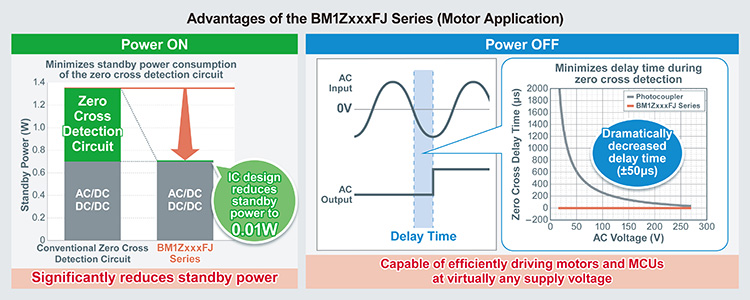AC Voltage Zero Cross Detection ICs
ROHM's BM1Z series output the AC voltage zero cross timing detection with high accuracy. By eliminating the need for photocoupler and external components required in conventional applications, it is possible to reduce the number of parts drastically and realize compact and highly reliable power supply applications. In addition, it can reduce standby power largely in comparison with an existing photocoupler control.
Parametric Search
Supporting Information
Overview
The BM1ZxxxFJ series reduces standby power consumption of the zero cross circuit to just 0.01W while continuously powering the system. What’s more, the error in delay time (which varies depending on the AC voltage) that exists with conventional photocoupler-equipped zero cross detection circuits is limited to ±50µs or less. This allows for the efficient drive of motors – even with the different AC supply voltages used in various countries and regions – as well as MCUs (which is difficult to achieve using conventional zero cross detection circuits). At the same time, eliminating the need for a photocoupler contributes to greater application reliability by reducing risks related to age-based degradation.
Key Features
1. Breakthrough photocoupler-less zero cross detection circuit design minimizes application standby power consumption
Conventional zero cross detection circuits commonly utilize a photocoupler and transistor that accounts for nearly half of the standby power consumption of the entire application. This time, after analyzing hundreds of power supply patterns in different environments, ROHM was able to achieve an IC capable of detecting the zero cross without a photocoupler.
Along with reducing the number of parts, the new design delivers a standby power consumption close to zero (0.01W). And in motor applications it is possible to further decrease component count along with standby power consumption by eliminating the motor input voltage detection circuit.

2. Contributes to improved reliability and efficiency in home appliances in a variety of countries and regions
Using a photocoupler involves risks that include performance degradation due to the deterioration in luminous intensity over time. Eliminating the photocoupler not only reduces this failure risk but also limits the delay time error, which can vary depending on the AC voltage, to ±50μs or less. This makes it possible to efficiently drive motors even with the different supply voltages (100-230V) used in various countries – as well as MCUs, which is difficult or impossible to achieve using conventional zero cross detection circuits.
3. Easily replace conventional zero cross detection circuits
The BM1ZxxxFJ series supports the waveforms (pulse/edge) and circuit topologies (standard rectification/double rectification) utilized in conventional zero cross detection circuits, allowing users to easily replace standard zero cross detection circuits equipped with a photocoupler without requiring software changes.
4. Integrated voltage clamp function protects the downstream MCU
The BM1ZxxxFJ series is compatible with input voltages up to 600V and performs voltage division to output below the maximum rated voltage of MCU and drive standard MCUs up to 5V. A voltage clamp function is also included that ensures the input voltage does not exceed 4.8V, protecting the MCU even when abnormal voltages are generated in high voltage drive applications such as air conditioners.
Application Examples
Home appliances equipped with motors such as air conditioners, washing machines, and vacuum cleaners

Evaluation Board
An integrated zero cross detection IC development board is available that integrates a power supply for driving ROHM’s integrated zero cross detection IC, facilitating device evaluation. This evaluation board is designed to simplify the decision-making process for designers when considering replacement of existing circuits using a photocoupler.
| Eval Board Part Number | Onboard Product | Functional Overview | Documentation |
|---|---|---|---|
| BM1Z002FJ-EVK-001 | BM1Z002FJ | AC zero cross detection circuit (non-isolated) | User's Guide |
| BM1Z002FJ-EVK-002 | BM1Z002FJ | AC zero cross detection circuit (isolated) | User's Guide |
| BM1Z102FJ-EVK-001 | BM1Z102FJ | AC zero cross detection circuit + DC voltage monitor (non-siolated) | User's Guide |


